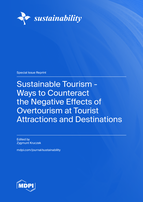Sustainable Tourism - Ways to Counteract the Negative Effects of Overtourism at Tourist Attractions and Destinations
A special issue of Sustainability (ISSN 2071-1050). This special issue belongs to the section "Tourism, Culture, and Heritage".
Deadline for manuscript submissions: closed (31 January 2020) | Viewed by 74107
Special Issue Editor
Interests: sustainable tourism; inclusive tourism; special interest tourism (mountain tourism; ecotourism, adventure tourism, cultural tourism, sport tourism); tourism attractions; regional aspects of the geography of tourism
Special Issues, Collections and Topics in MDPI journals
Special Issue Information
Dear colleagues,
The purpose of this Special Issue is to publish current research and literature on overtourism and sustainable tourism as a way to eliminate or limit the effects of excessive tourism.
In particular, this Special Issue of the peer-reviewed international journal Sustainability aspires to expand the discussion and scholarship on a range of viewpoints, trends, approaches, cases, success factors, impacts, challenges, models and/or frameworks of relevance to tourism in regions and cities, as well as cultural and natural attractions threatened by the negative effects of overtourism.
In the tourism literature from the last two years, overtourism has been the most commonly discussed topic in both the media and by the scientific community. The excessive presence of tourists leads to congestion in attractive locations, over-advertising and aggressive commercialization, as well as a subsequent decrease in the level of aesthetic experiences for tourists. It also results in degradation of both natural and cultural resources. The effect of excessive tourism is an increase in the price of services, rental fees and real estate, and depopulation in districts exploited by tourism. In cities with a long history, it causes the gentrification of historical areas.
Overtourism results in the limits of socio-psychological capacity of residents being exceeded, resulting in the dissatisfaction of residents and protests against the further development of tourism. The residents’ dissatisfaction also affects the ‘local atmosphere’ experienced by tourists.
This Special Issue aims to explore further sustainable tourism practices, outcomes and success factors for areas affected by overtourism with an interdisciplinary and multi-sectorial approach. Potential areas of focus are cities, natural attractions (e.g. national parks), reserves, cultural objects (e.g. those on the World Heritage List), museums and other sensitive places. Topics may include, but not be limited to the following within the context of sustainable tourism:
- challenges and opportunities in areas affected by the excessive tourist frequency regarding tourism development
- overtourism in:
- national parks and nature reserves
- cities and resorts
- cultural attractions (museums, theme parks, events, etc.)
- coastal tourism and cruise tourism in the time of overtourism
- overtourism and seasonality
- climate change and overtourism
- overtourism in world heritage areas
- tourism gentrification of historic districts
- tourism products and customer experiences in overtourism places and regions
- historic aspects of tourism in sensitive areas
- smart tourism and smart attractions
- sustainable tourism monitoring towards identifying early symptoms of overtourism
- destination governance and DMO’s responsibilities and decision-making schemes in destinations affected or threatened by overtourism,
- methods and strategies to mitigate the effects of overtourism
- overtourism-induced conflicts, relationships between visitors, inhabitants and tourism entrepreneurs
- sharing economy, platform economy, and overtourism
- impact of technology on tourism destinations
- co-creation, experience economy and experiential travel in the area of overtourism
- impact of overtourism on the housing market
- SMEs and family firms in overtourism destinations
- tourism policy towards overtourism: transnational, national, regional, and destination level
- nighttime economy and overtourism
- diagnostic indicators for measuring traffic overload,
- ways to counteract excessive overload of tourist traffic in spa areas.
Regional and international case studies, original research with quantitative investigation, theoretical frameworks and models and other relevant illustrations of the significance of sustainable tourism in overtourism destinations will be considered for this Special Issue.
Prof. Dr. Zygmunt Kruczek
Guest Editor
Manuscript Submission Information
Manuscripts should be submitted online at www.mdpi.com by registering and logging in to this website. Once you are registered, click here to go to the submission form. Manuscripts can be submitted until the deadline. All submissions that pass pre-check are peer-reviewed. Accepted papers will be published continuously in the journal (as soon as accepted) and will be listed together on the special issue website. Research articles, review articles as well as short communications are invited. For planned papers, a title and short abstract (about 100 words) can be sent to the Editorial Office for announcement on this website.
Submitted manuscripts should not have been published previously, nor be under consideration for publication elsewhere (except conference proceedings papers). All manuscripts are thoroughly refereed through a single-blind peer-review process. A guide for authors and other relevant information for submission of manuscripts is available on the Instructions for Authors page. Sustainability is an international peer-reviewed open access semimonthly journal published by MDPI.
Please visit the Instructions for Authors page before submitting a manuscript. The Article Processing Charge (APC) for publication in this open access journal is 2400 CHF (Swiss Francs). Submitted papers should be well formatted and use good English. Authors may use MDPI's English editing service prior to publication or during author revisions.
Keywords
- Overtourism
- threats
- sustainable tourism
- city tourism
- gentrification
- coastal tourism and cruising
- national parks
- nature reserves
- tourist attractions
- customer experiences
- development and planning
- strategies
- smart tourism
- smart attractions
- nighttime economy
- sharing economy
- co-creation
- experiential travel
- diagnostic indicators
- spa area






